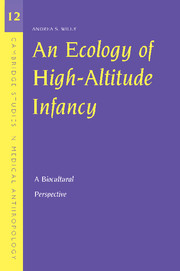Book contents
- Frontmatter
- Contents
- List of Figures, Photographs, and Tables
- Acknowledgments
- Abbreviations
- Glossary of Ladakhi Words
- An Ecology of High-Altitude Infancy
- 1 Introduction
- 2 Challenges of High-Altitude Living
- 3 Contextualizing Reproductive Health Research in Ladakh
- 4 Big Mountains, Small Babies
- 5 An Ecology of Infancy in Ladakh
- 6 Comparative Perspectives on Reproductive Health in Ladakh
- 7 Toward Relevant Research: Adaptation and Policy Perspectives on Maternal-Infant Health in Ladakh
- Notes
- References
- Index
- Titles in the series
6 - Comparative Perspectives on Reproductive Health in Ladakh
Published online by Cambridge University Press: 18 December 2009
- Frontmatter
- Contents
- List of Figures, Photographs, and Tables
- Acknowledgments
- Abbreviations
- Glossary of Ladakhi Words
- An Ecology of High-Altitude Infancy
- 1 Introduction
- 2 Challenges of High-Altitude Living
- 3 Contextualizing Reproductive Health Research in Ladakh
- 4 Big Mountains, Small Babies
- 5 An Ecology of Infancy in Ladakh
- 6 Comparative Perspectives on Reproductive Health in Ladakh
- 7 Toward Relevant Research: Adaptation and Policy Perspectives on Maternal-Infant Health in Ladakh
- Notes
- References
- Index
- Titles in the series
Summary
The previous two chapters described a number of striking features of reproductive health in Ladakh. Some result from the ecology of this mountainous region, while others derive from the social and cultural forms extant in Ladakh in the 1990s. Aspects of these are unique to Ladakh, but many are common to the Himalayan culture area. In addition, some derive from similar social and historical processes of the Indian subcontinent. Hence, the significance of the Ladakhi material is highlighted by three comparisons: (1) mountain populations from the New World that share a similar mountain ecology, for which there are extensive data; (2) other Himalayan populations that share ecology, social organization, and cultural traditions, albeit with different historical trajectories; and (3) other populations in India, with which Ladakh shares some infrastructural similarities and social trends. Each of these three comparisons provides different ways of understanding the possible roots of the reproductive health situation observed in Ladakh.
Comparisons focus on the significant aspects of maternal and child health in Ladakh, and include birthweight and Ponderal Index; maternal biology; diet and work patterns during pregnancy; neonatal and infant mortality rates and their relationship to patterns of morbidity; child care and gender differentials in health and survival; and household and family dynamics.
- Type
- Chapter
- Information
- An Ecology of High-Altitude InfancyA Biocultural Perspective, pp. 146 - 177Publisher: Cambridge University PressPrint publication year: 2004



